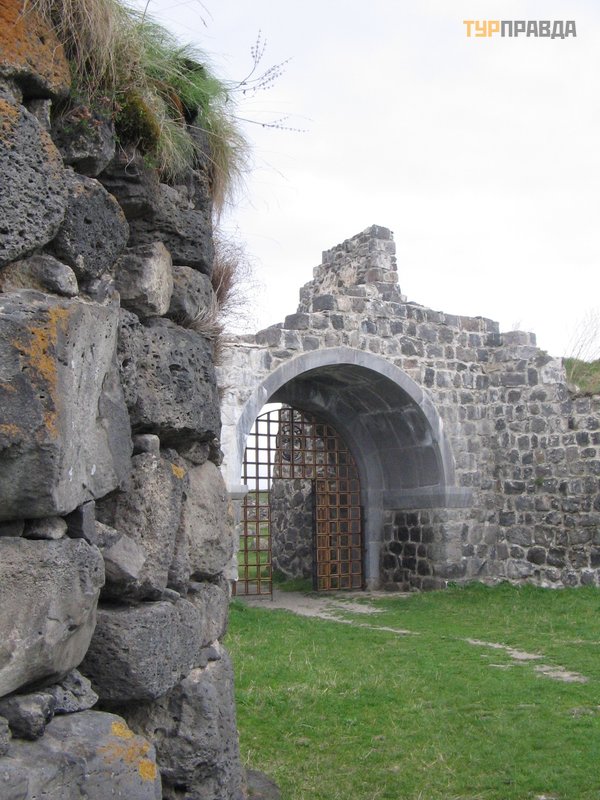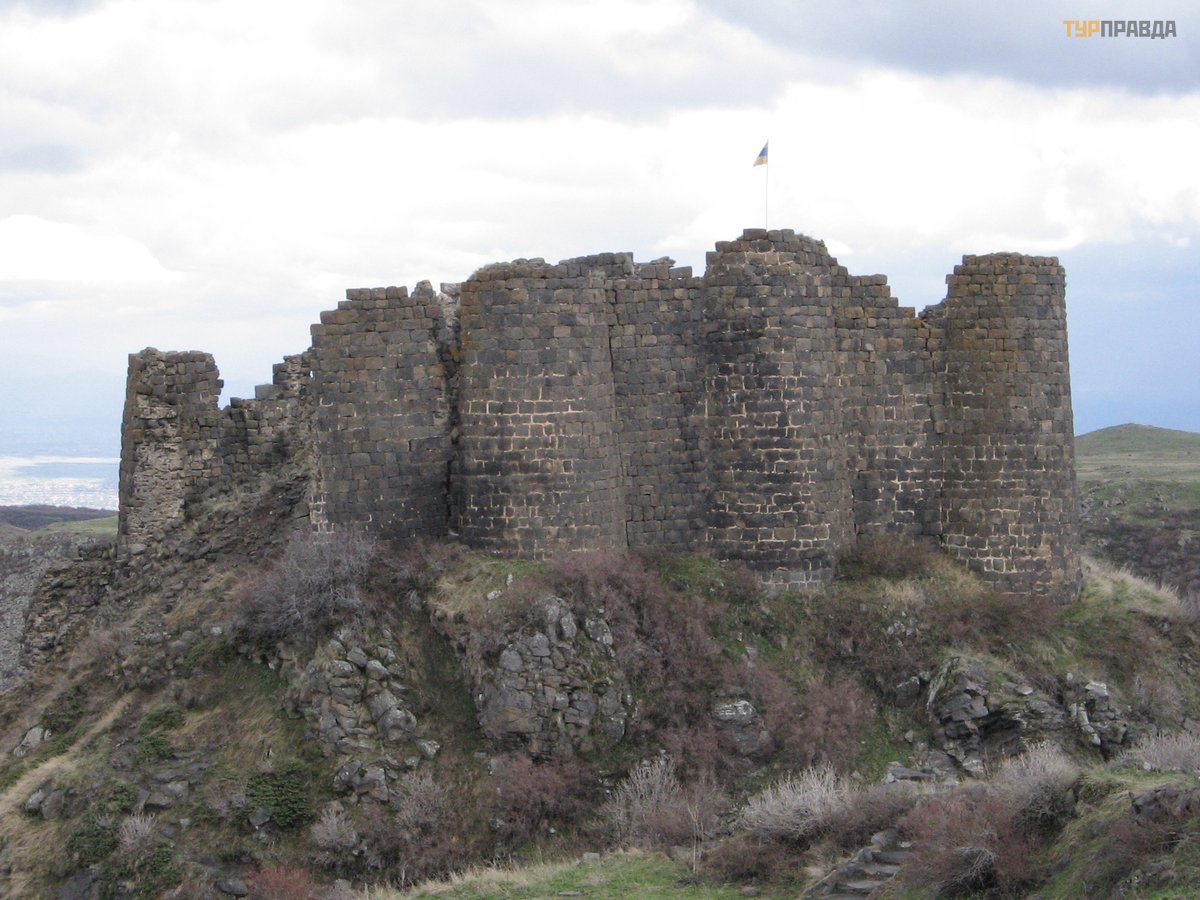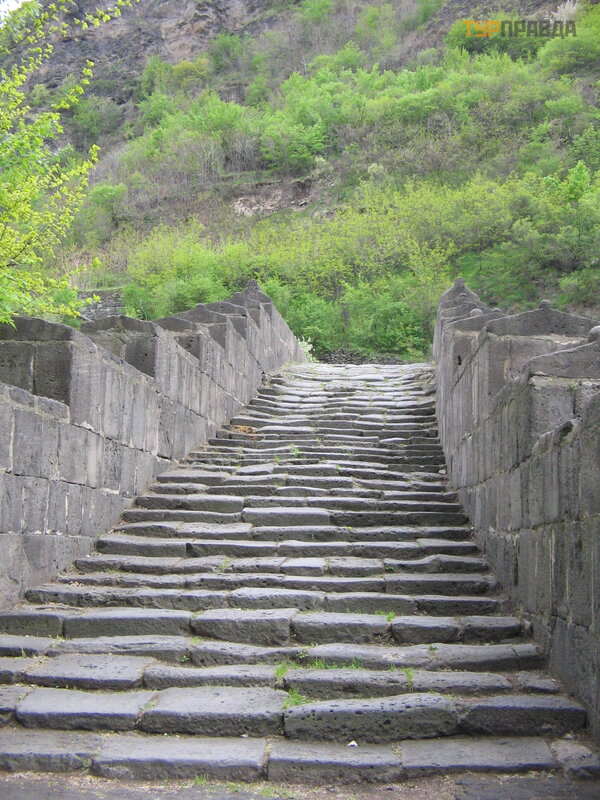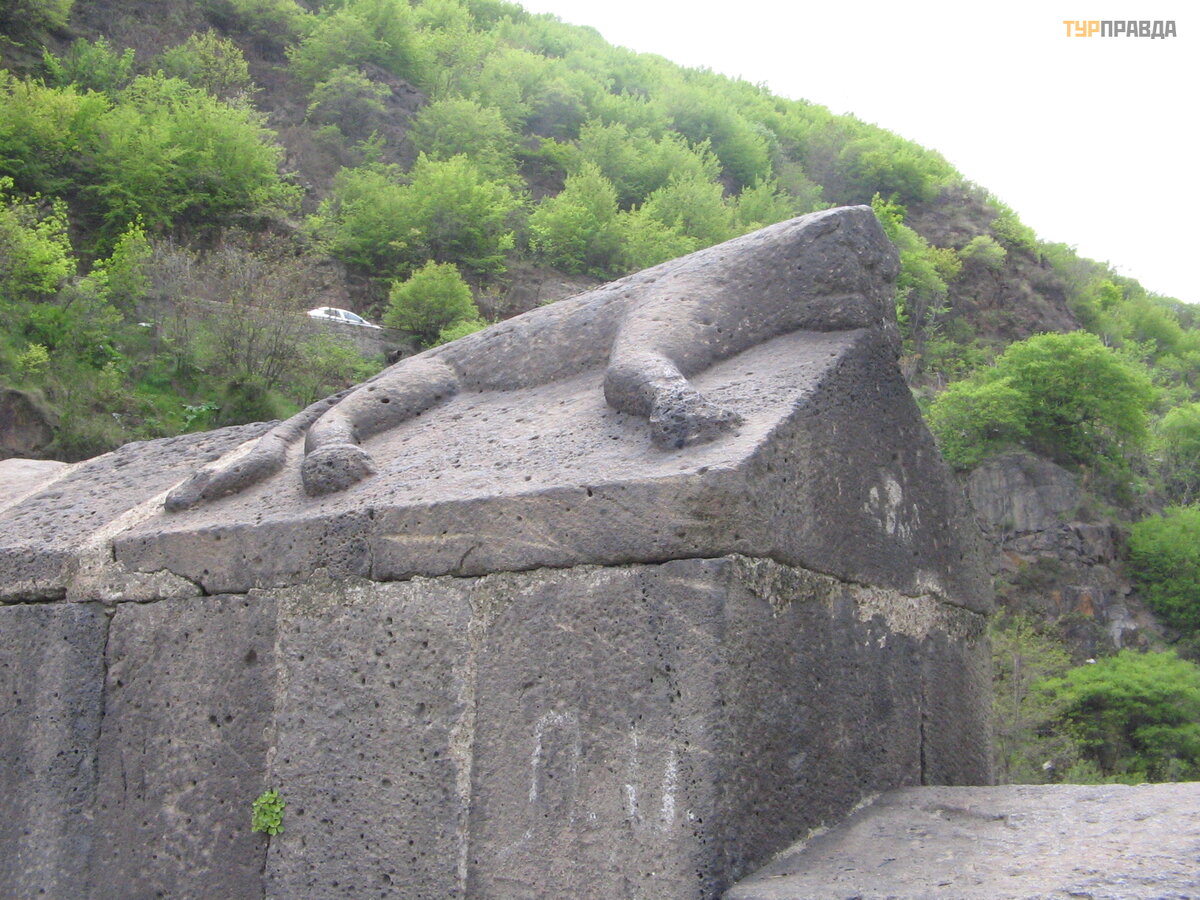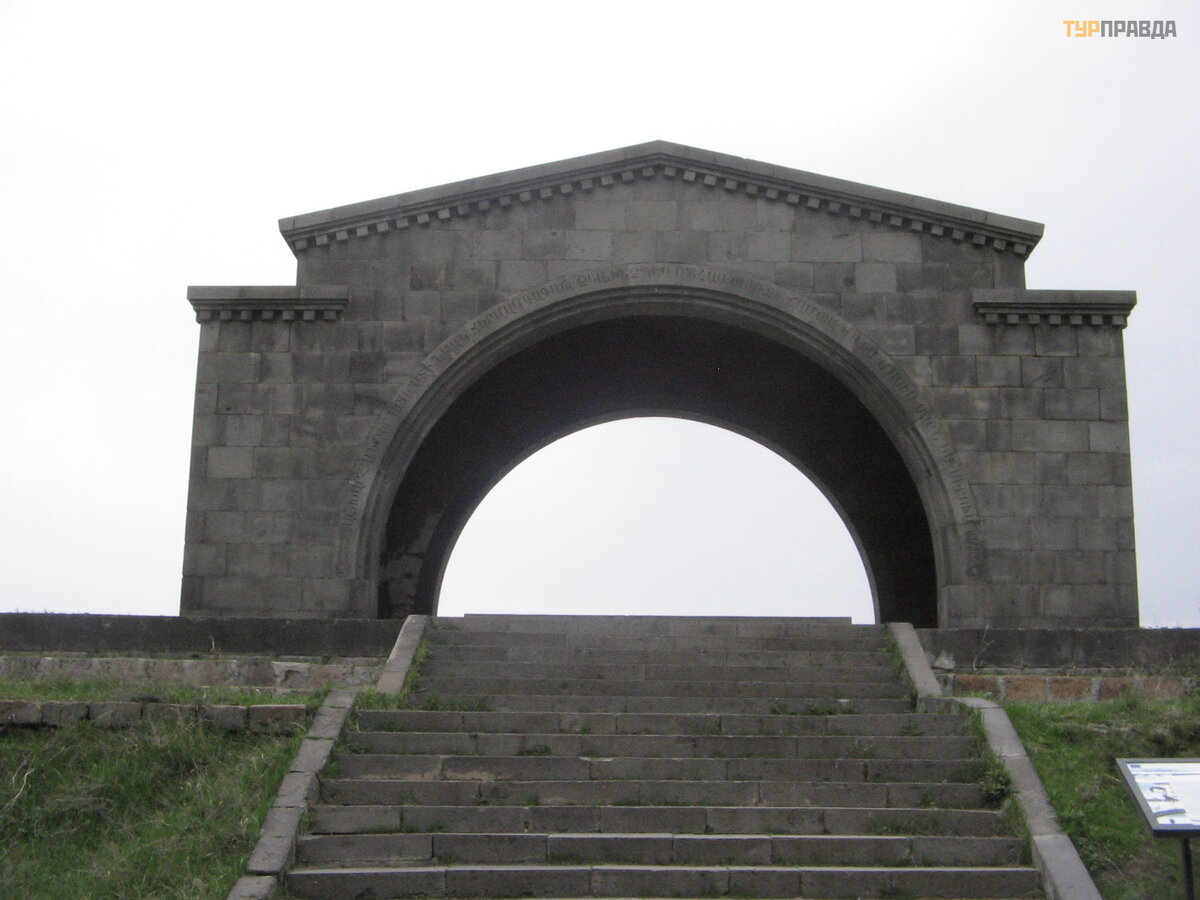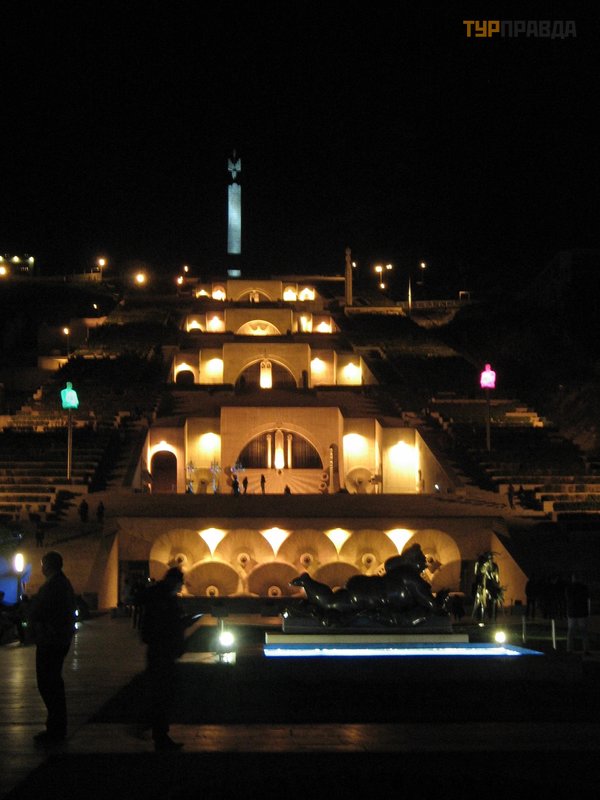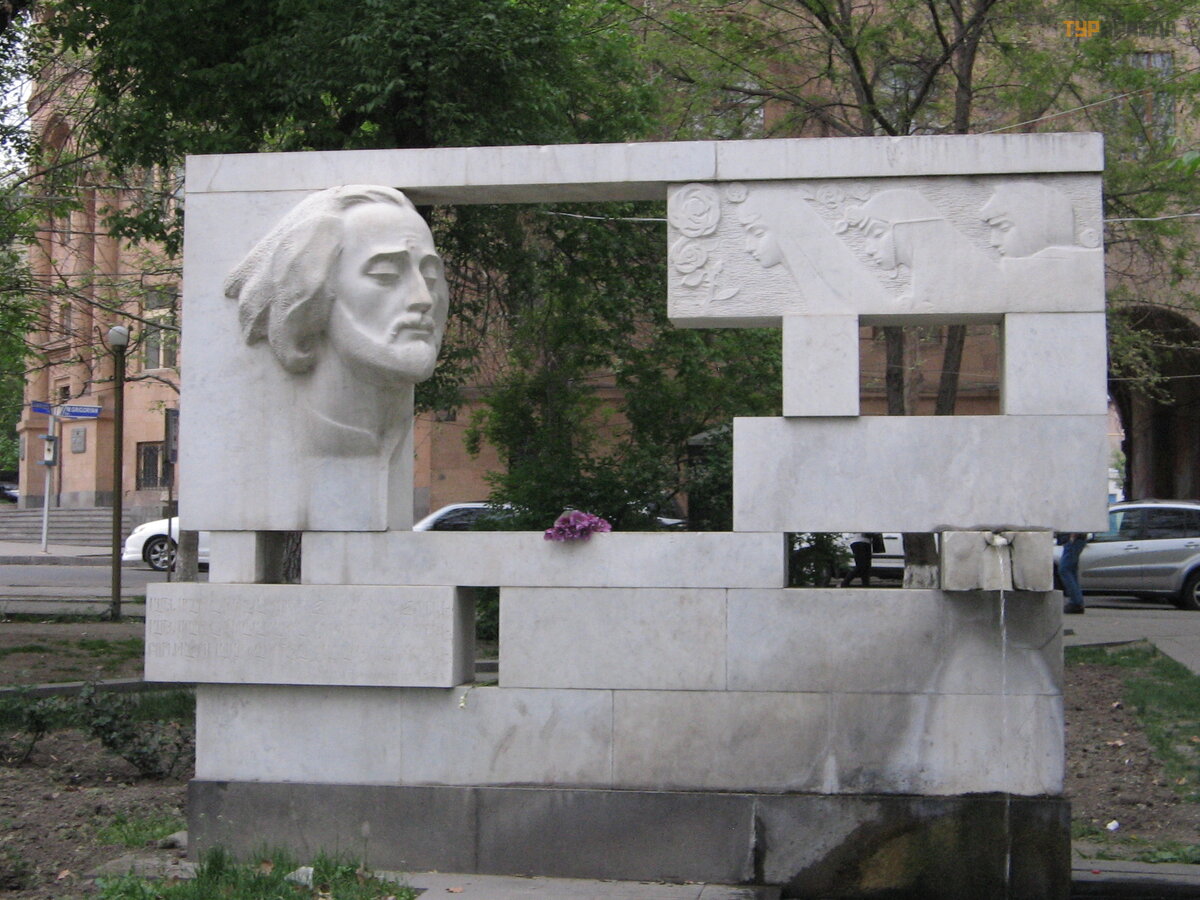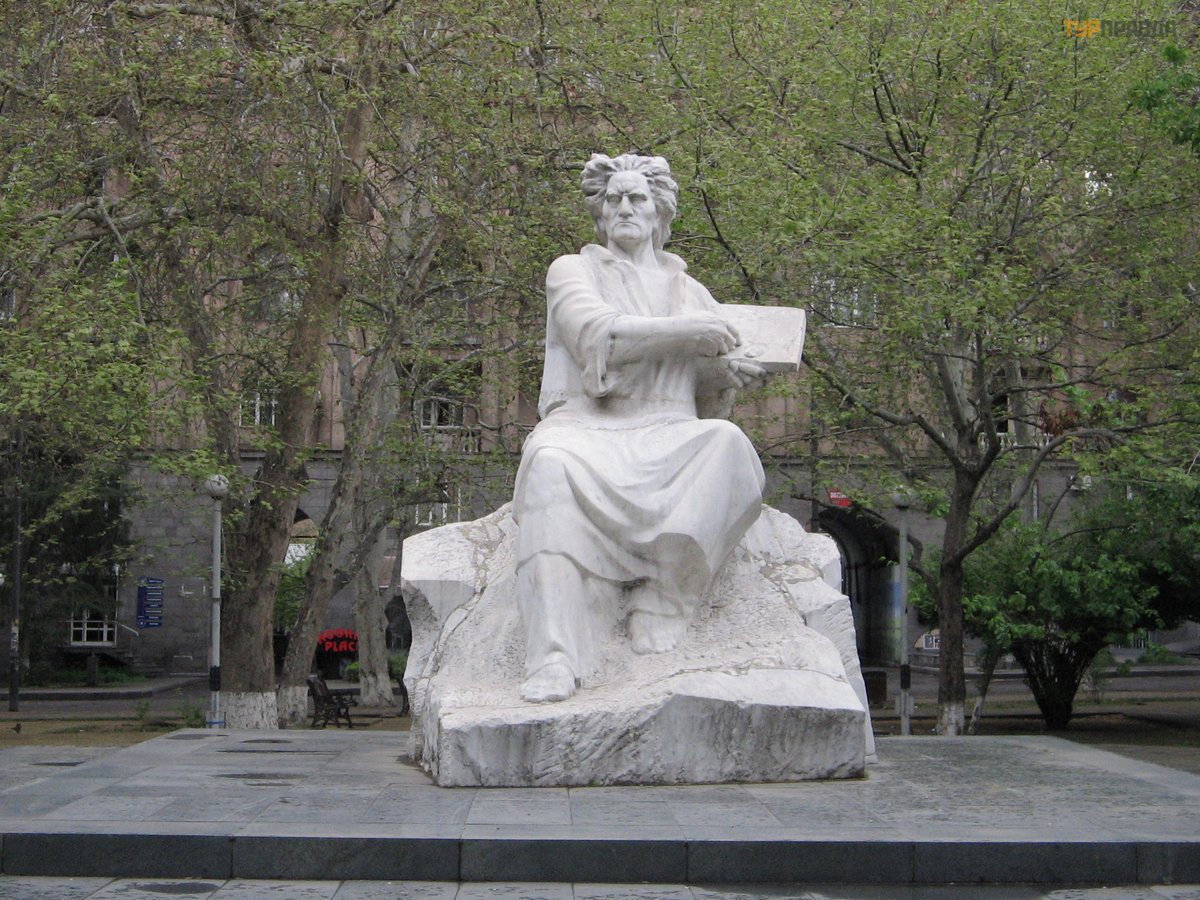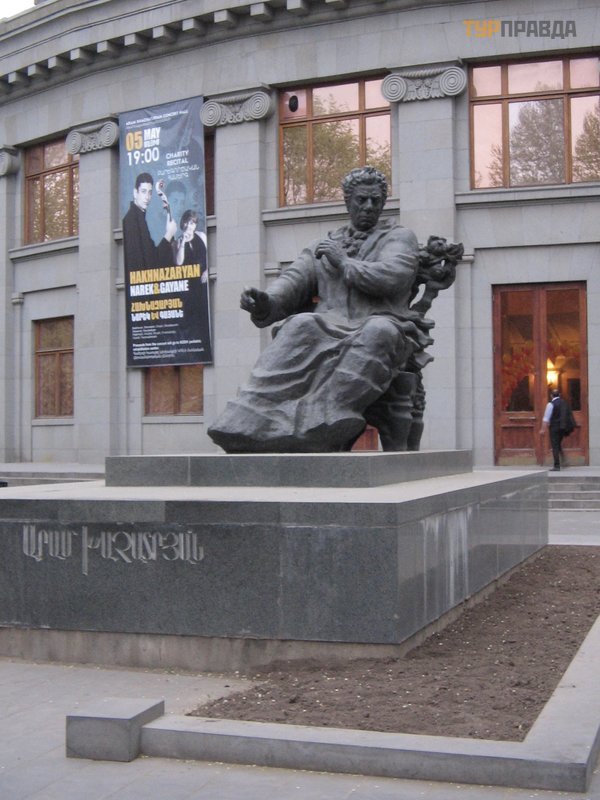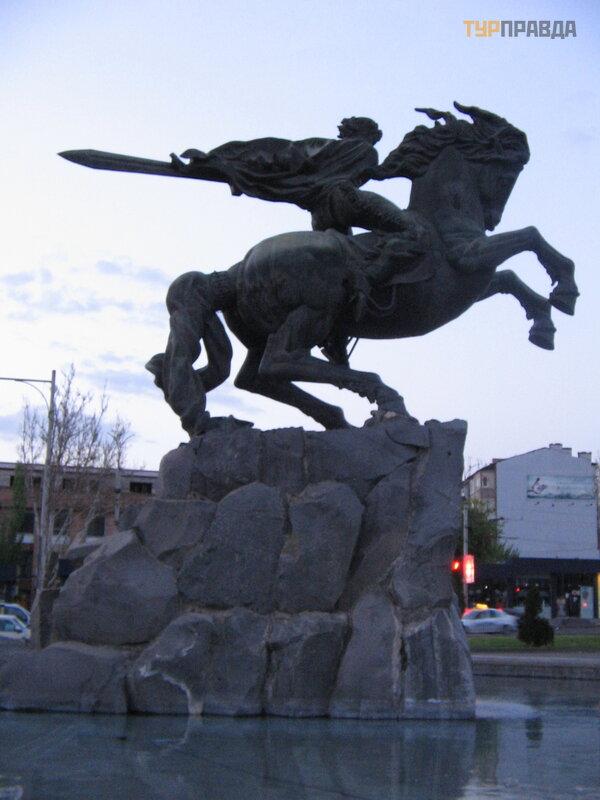Monuments tangible and intangible. Part 2
Scheme of the described trip here. Beginning - see part 1
I skip the centuries of the beginning of Christianity and the construction of temples, monasteries, schools after the appearance of the alphabet. Then the task of Christianization was the most important for the country: to unite and survive in the face of constant raids. When the Arabs appeared (who had just converted to Islam and were expanding the caliphate), churches and monasteries were already there. They always and everywhere performed the function of a fortress and protection of the local population from raids. The Mongols who appeared later were not interested in religion, but in those days the country had no time for construction.
Middle Ages. In the XII century, the Armenian royal dynasty will cease, and with it the Armenian statehood. Only separate principalities will remain, which will fight for their land alone. Each owner of land protects them from neighbors. Fortresses of the 10th-13th centuries stand on rocks, over cliffs (like Garni), using natural rock formations for protection. Below, streams or rivers flow in the gorges. From above, you can see all the approach paths on which the enemy can appear. Only gentle parts are protected by walls.
I will mention two fortresses that we saw, and which were built specifically for security purposes. There were churches in them, but they are small, for the needs of the defenders. The first - Amberd fortress - stands on the slope of Aragats. Below, two water streams merge, roads, paths and a valley with present-day Ashtarak and Yerevan are visible. The second - Lori Bird - not far from Stepanavan - stands above the cliff of the Dzoraget River and its tributary.
Lori Bird [5] was founded in the 11th century by a relative of the royal Bagratid dynasty from Ani (now in Turkey, near the border with Armenia). The fortress guarded the way from the north from Georgia (where the younger Bagratids were on the throne) to the south to Ani. Since the Lori region adjoins Georgia, it is possible that the fortress guarded Georgian lands rather than Armenian ones. Here I will mention the princely family of Zakaryans, who at one time owned this fortress, and they served the Georgian Bagratids and had vast lands in the north of present-day Armenia for their merits in their liberation from the Mongols. In the fortress, a wall was restored on a plateau with a gate; there is a building, which may have been a church before. The rest is in ruins. At the bottom, an arched bridge has been preserved. The fortress was captured by the Turks, and the Persians, and the Mongols. As the inscription at the entrance says, everything that was found during the excavations can be seen in the Shahumyan Museum in Stepanavan.
Amberd Fortress [31] was built in the 10th-13th centuries. Some parts were erected as early as the 8th century, although some suggest that the fortress existed here in Urartian times, which is not confirmed by excavations. It was the property of Prince Pahlavuni (and this clan was "responsible" for managing the royal treasury). She defended the possessions of the Bagratids (while they were on the royal throne), then local princes.
It can be approached from two directions: from the new monument to the alphabet (on the M3 highway) and through Byurakan on the southern slopes of Aragats (both roads pass through Ashtarak). Somewhere at the top of the road merge into one. The fortress stands at the confluence of the Amberd and Arkashen rivers at an altitude of more than 2 km (because it was snowing there). At various times it was captured by the Seljuks, the Mongols. In addition to the fortress itself, the ruins of a bathhouse and a church with an amazing roof, similar to a pleated skirt, have been preserved.
The medieval Sanain bridge [7] across the Debed River has been preserved since the 12th century. (there is an old bridge in Ashtarak, but I didn’t see it - I don’t write). We did not notice him, going down to the river from Odzun and going up to the Sanahin monastery. It is located in the city of Alaverdi. The locals explained to us that the easiest way to find it is along the copper plant, moving along the main street of the city along the river, but not along the M6, but along the other bank. Oh, this plant is hard not to notice: either steam, or fog, or... It was visible over all the gorges and rocks all the time. But we drove around the city in search of a bridge on purpose. Nearby is the funicular to Sanahin (did I mention it's under renovation right now? ).
This bridge is the best preserved of the medieval ones. It was built by order of the sister of the princes Zakaryans. One side of it is a staircase, the other is horizontal, and then the ascent to the Sanahin monastery. The parapets are decorated with lions, for some reason sprawled on the stones like frogs.
Of course, it can be assumed that the Silk Road passes through Armenia. But this thought never crossed my mind before visiting Armenia. It is not very clear where he was going here and why it was necessary to choose such a difficult route - through the Caucasus. To Georgia in the Kura valley? To the Black Sea to Tauris? Well, if to the north, then along the Caspian Sea or the Central Asian rivers and even deserts, it seems, it is easier to get there. Usually you imagine the Mediterranean as the final goal of this long journey (the monument to the beginning of the journey in Xi'an was briefly shown to us). But they traded everywhere, and therefore they also carried goods through the impregnable Caucasus. At least through Derbent along the Caspian Sea. Hypothetically, she knew that there were very difficult sections of this path, such as the Takla-Makan and Gobi deserts, the high mountains of the Pamirs, the Tien Shan... Seeing the mountain passes with my own eyes, I seemed to have discarded the possibility of such movements. And, being at an altitude of more than 2 km in the Selim caravanserai[20], she could not realize that loaded caravans could climb here and spend the night in this cold. Except in summer. Even today it is not easy. And in the Middle Ages?
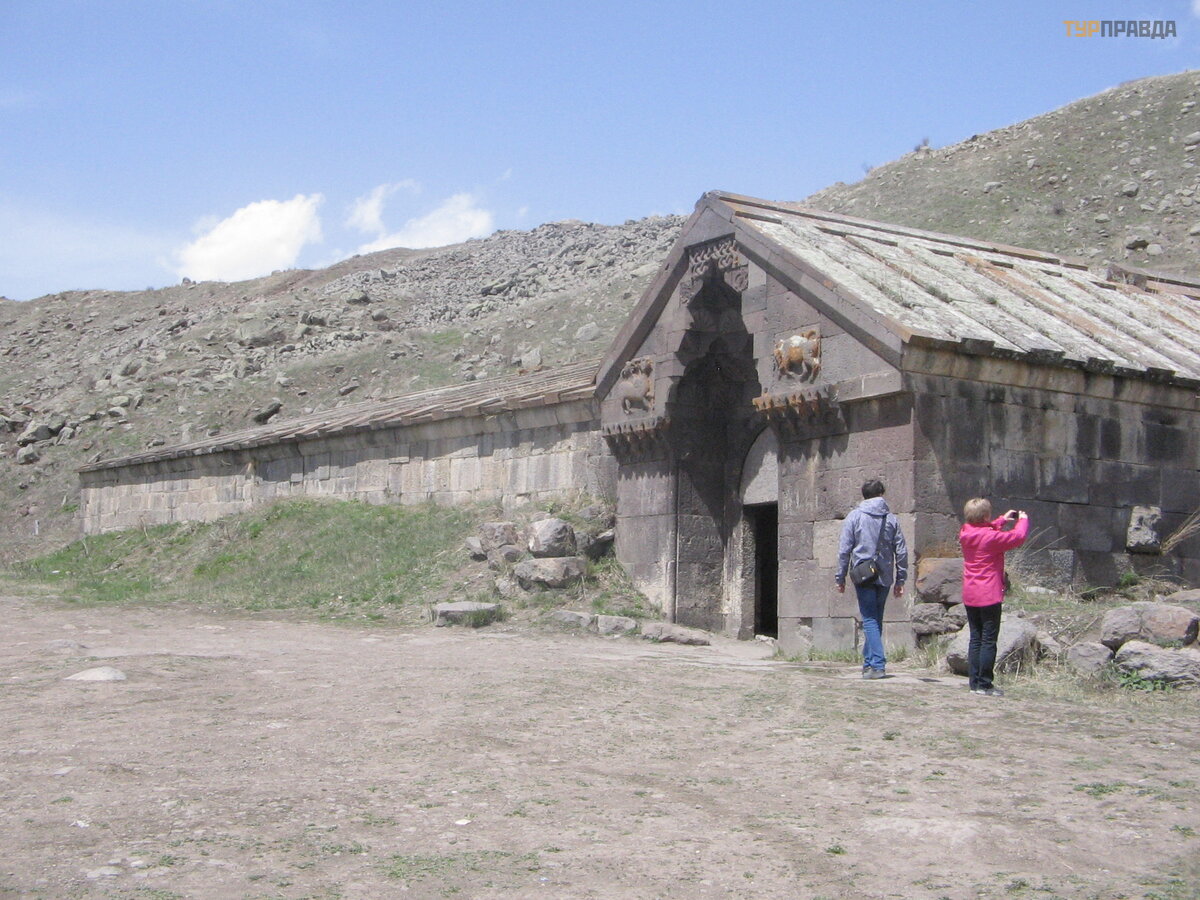 general view of the Selim caravanserai
general view of the Selim caravanserai
Inns were built on approximately equal segments of the path that a caravan of loaded animals (10-25 km) could cover in a day. The caravanserai existed on this site as early as the 4th century. In the XIV century, by order of Prince Orbelyan, it was rebuilt. This is evidenced by the image above the entrance of a bull and a lion with a human face in a crown and an inscription. First you get to the part where, apparently, they cooked food, because. here is the stove. From this hall there is a passage to a long hall, where animals were placed along the walls. The drovers occupied small rooms nearby, at the end of the large one. Outside, to the right of the entrance, the ruins of the chapel have been preserved.
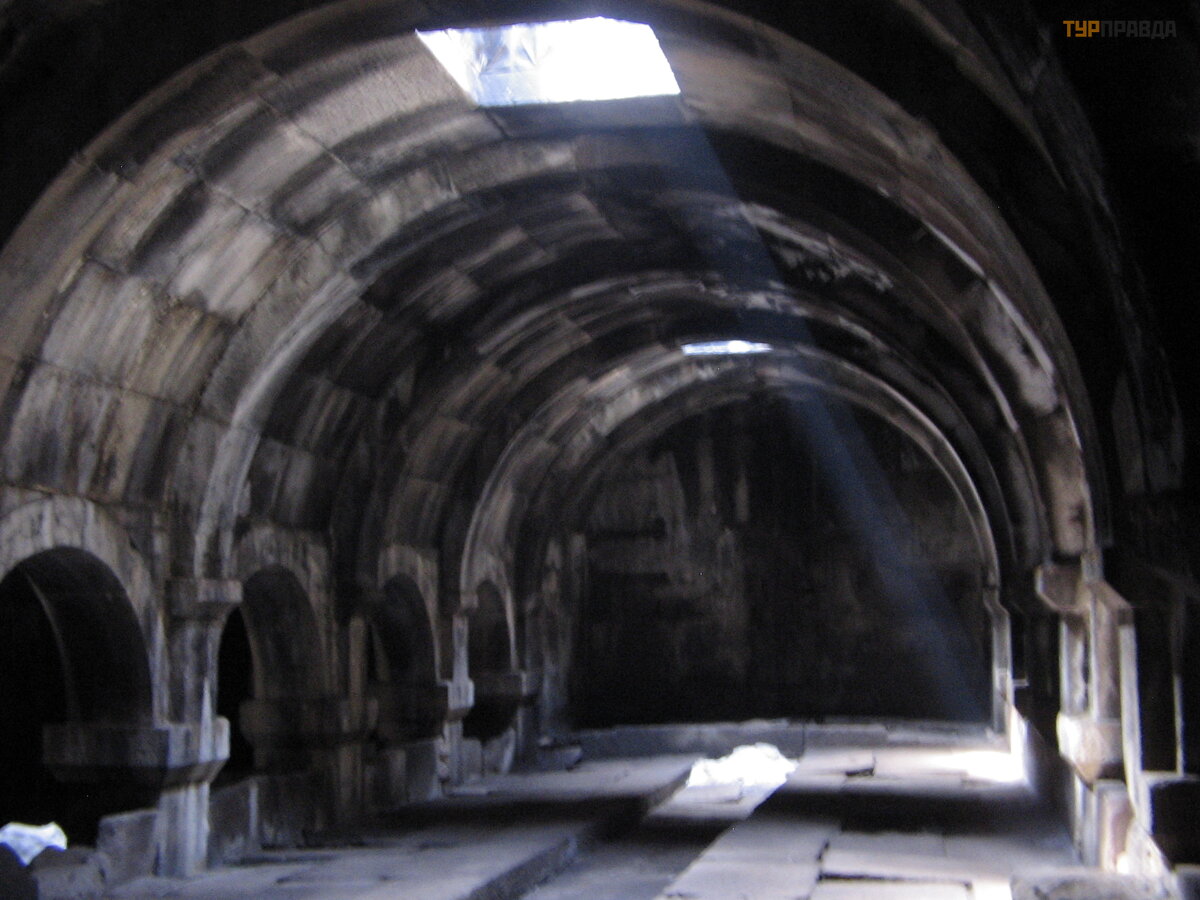 interior for animals (caravanserai)
interior for animals (caravanserai)
When the royal family of the Bagratids ended, Armenia lost its statehood for centuries. Separate principalities existed as best they could, depending on the invaders or neighbors. Therefore, little was built and preserved from the buildings of this period. Only churches were built, and even that was not enough. I will finish with monuments of the 20th century.
On the way to Garni, tourists are shown a viewpoint called “Arch of Charents” [26]. In fact, from there through the arch opens a view of Ararat. But we were not lucky: Ararat decided not to show itself to us. Who is this Charents? Poet, translator - on the one hand, but also a revolutionary - on the other. The date of his death - 1937 - explains a lot. In addition to Arka, in modern Armenia there is a city named after him on the river. Hrazdan, a museum in Yerevan, his portrait is depicted on the front side of the 1000 AMD bill.
When the first Republic of Armenia was formed in 1920, Yerevan [12] from almost a village (as many cities in the East look like) gradually turns into a capital city (it became the official capital in 1918).
I will say right away: Yerevan is “not my city”. There are almost no old buildings. And the new ones are similar to each other: they were built according to the unified urban planning plan of the architect Tamanyan in the 20-30s. They are made, however, not of concrete or brick, but of pinkish tuff that adorns them. The architect who rebuilt the city is respected: he is depicted on the banknote of 5000 drams, he is buried in the Pantheon of Komitas Park (there is one in the south of the city). Near the Cascade there is a monument to him (next to the street named after the architect). He relies on books, I thought it was Mashtots again. But the guide explained to me: no, this is an architect, but we also respect him.
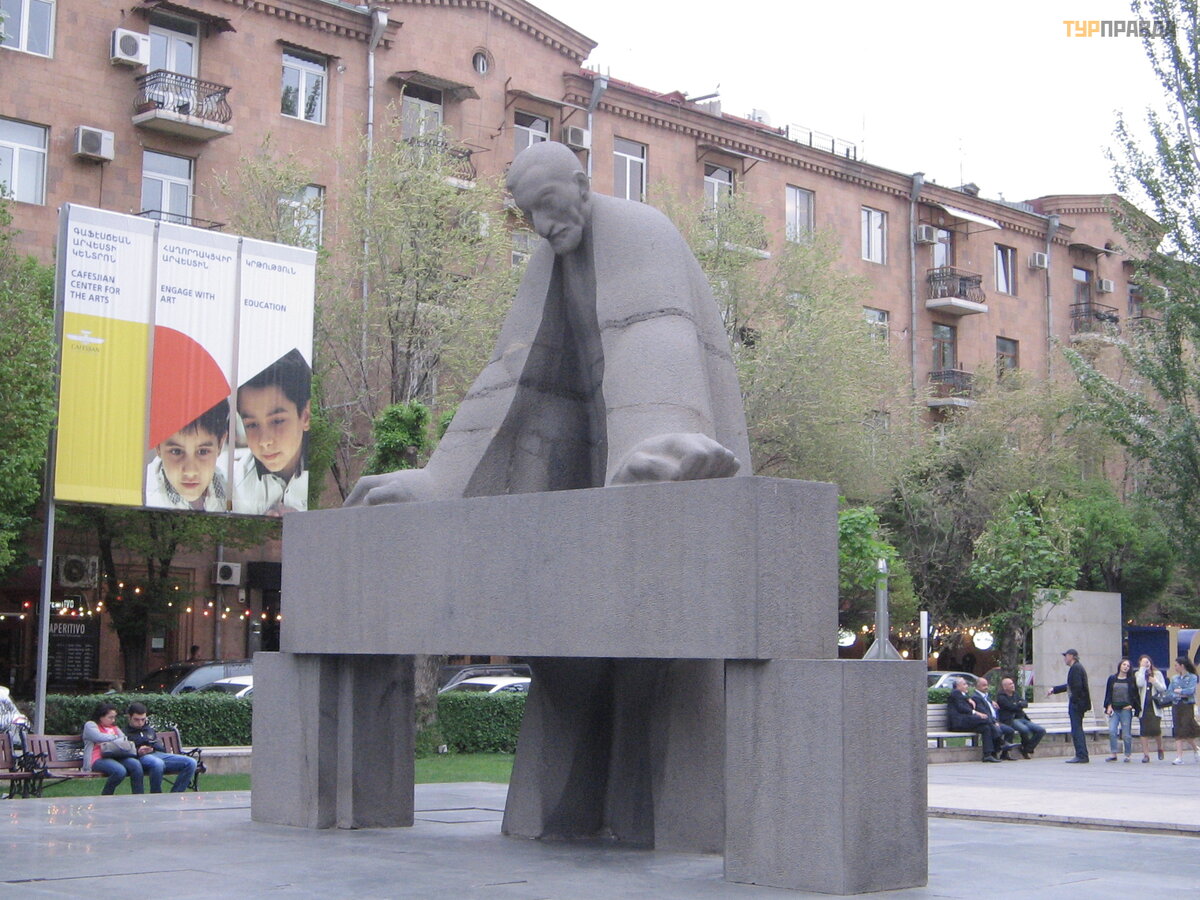 monument to architect Tamanyan
monument to architect Tamanyan
I didn't have much desire and time to walk around the city with new buildings. But even in my short walks I noticed that there are many monuments on the streets and squares. And not so much to political figures, but to historical characters and cultural figures, which pleases. I will list a few. Those who wish can continue to explore others in their walks around the city (and country).
Most of the monuments of Yerevan are concentrated on the ring boulevard and inside it.
We lived near the Cascade (the Museum of Contemporary Art of the Cafesjian Foundation). From my attic, the side part of this staircase was visible. Several central squares depart from the Cascade.
At the Cascade there is a huge number of modern monuments, sometimes more than strange. There were a few curious people inside and out during our visit. For example, I was interested in a picture on a historical theme with a huge amount. The guide spoke for a long time about the people depicted on it. Their names didn't mean anything to me at the time. Only now some have found their place in the head. But photography is not allowed inside.
 near Cascade (made from tires)
near Cascade (made from tires)
France Square is located below. In the squares around it, you can find monuments to Sayat-Nova, Komitas, Saryan and others.
Sayat-Nova (if someone, like me before the trip, this name means nothing) - ashug (singer, bard). He lived in the XVIII century, wrote his poems in several languages: Georgian, Armenian, Azerbaijani. Since childhood, he had many talents. Before becoming an ashug, he invented a portable loom. Already being an ashug, he played several musical instruments, composed poems in the competition of poets, when one continues the verse of another. For many years he served at the Georgian court. He spent several years in Haghpat Monastery. Buried in Tbilisi. Parajanov's film "The Color of Pomegranate" was made about him. There is an avenue named after him in Yerevan. The Rose Festival in Tbilisi is celebrated at his grave. A crater on Mercury is even named after him. And today, not only connoisseurs of poetry listen to songs based on his poems.
I will tell a legend about Sayat-Nova.
A bard served at the court of the Georgian king Heraclius. The king loved the art of singers, often arranged their competitions. A well-known singer from Spain came to compete with Sayat-Nova in the art of versification to the questions being asked. The winner, in addition to a monetary reward, received a musical instrument of the vanquished.
The Spanish singer was known both in the East and in the West. His instrument - saz - was richly decorated with precious stones. His poems were unexpected and well-marked. He has already defeated many. He was the first to ask questions to Sayat-Nova, and he answered all 30 with his usual erudition, without losing his rhyme. When Sayat-Nova's turn came, the Spanish bard stopped at the 26th verse-answer: his tongue was slurring.
The judges already wanted to declare Sayat-Nova the winner, but he gave the opponent a chance by repeating the questions again. Again, the Spanish bard was unable to answer the latter. He admitted defeat, put the saz on the carpet. At that moment, Sayat-Nova returned the instrument to the Spaniard. He said, “The instrument is a bard's honor. Although we are different, we are brothers. And you can’t take honor from a brother. ” The Spaniard composed a verse in honor of Sayat-Nova.
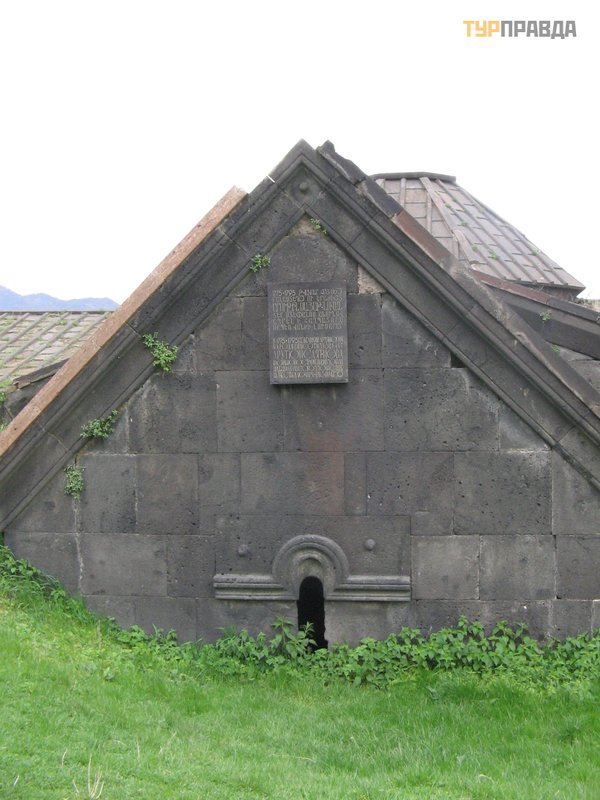 a plaque that Sayat-Nova lived in Haghpat
a plaque that Sayat-Nova lived in Haghpat
There is a monument to Komitas near the conservatory bearing his name. As a child, S. Soghomonyan did not know Armenian. Orphaned early, but possessing an amazingly beautiful voice, he was brought to Etchmiadzin to study at the seminary. He becomes a priest, but his interest in Armenian music makes him travel around the country all the time, collecting it. He organizes choirs. He studies music in Tbilisi, Europe, lectures there about Armenian music. Not finding understanding in Etchmiadzin, he leaves for Istanbul. But the time for this turned out to be unfortunate. In 1915, he, like other Armenian cultural figures, was arrested and exiled to the outback. The pogroms and murders of those around him made an indelible impression on him, his mind cannot stand it. And although he is rescued from Turkey by European friends, he spends the last years of his life in France in a mental hospital. A conservatory in Yerevan, a music hall, a street, a park where the Pantheon of Armenian cultural figures is located, a museum-institute are named after him. There are squares and monuments named after him in other cities and countries (including ours).
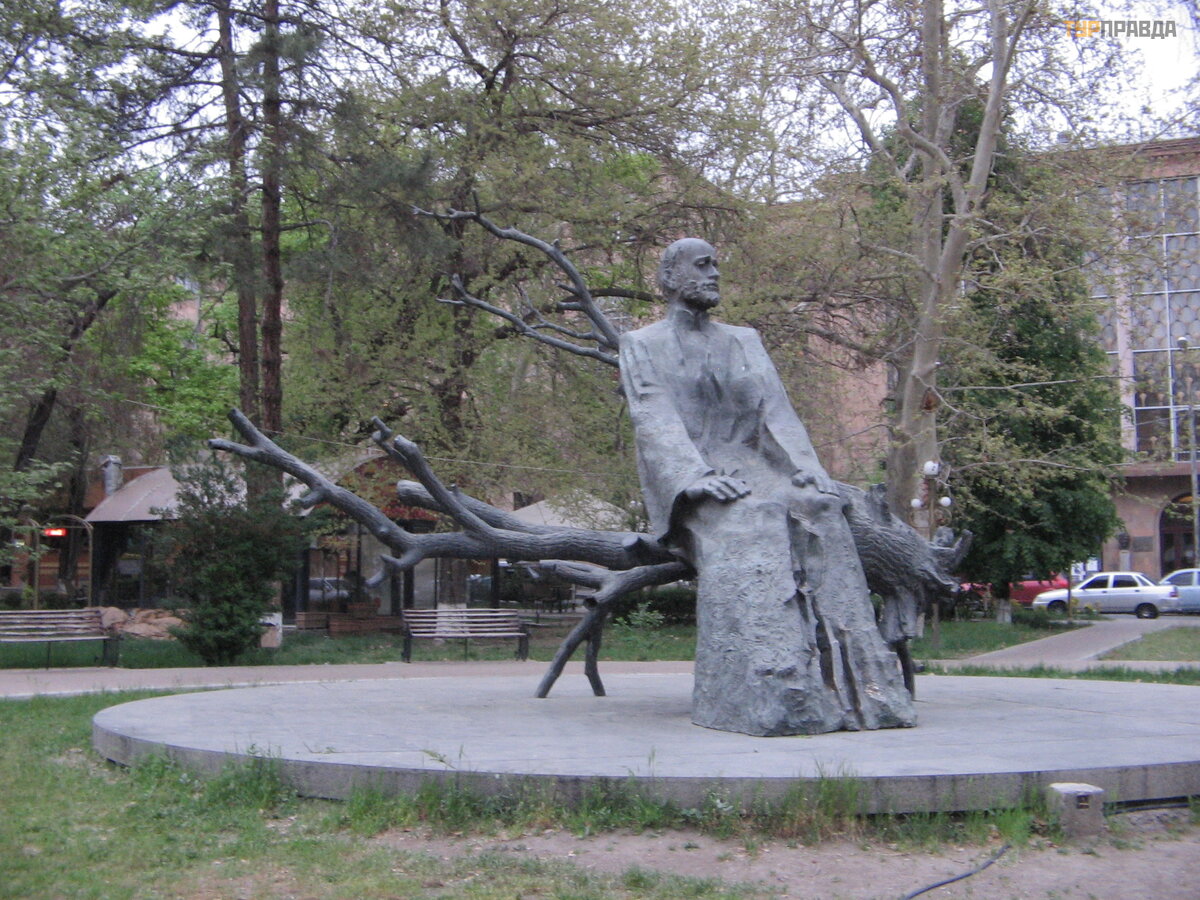 Comitas monument at the conservatory
Comitas monument at the conservatory
The artist Sarian is probably the most famous. Although I have not seen his paintings in Yerevan. Yes, and in the Russian Museum or the Tretyakov Gallery, too. Most of his life he painted the nature of Armenia. He was buried in the Pantheon of Komitas Park in Yerevan. One of the streets of Yerevan is named after him, he and part of his most famous painting “Armenia” are depicted on the banknote of 20.000 drams.
France Square smoothly turns into Azatutyan Square. And in the middle is the Opera House. Spendiarova (composer and conductor). It is surrounded by several monuments, quite recognizable: at the entrance - to Khachaturian, by Swan Lake (resembling Sevan in shape) - to Babajanyan. I will not talk about them.
We were at the ballet "Spartacus" by Khachaturian inside the opera house. For those who also want to get there, I will inform you that the entrance “behind Khachaturian’s back” is not into the hall. If you stand facing the monument, then on the left is the ticket office of the concert hall, on the right is the ticket office of the hall where we watched the ballet, the entrance is there. Inside the hall is convenient for watching the ballet: all rows rise up. But the locals don't seem to go there: there were almost only tourists.
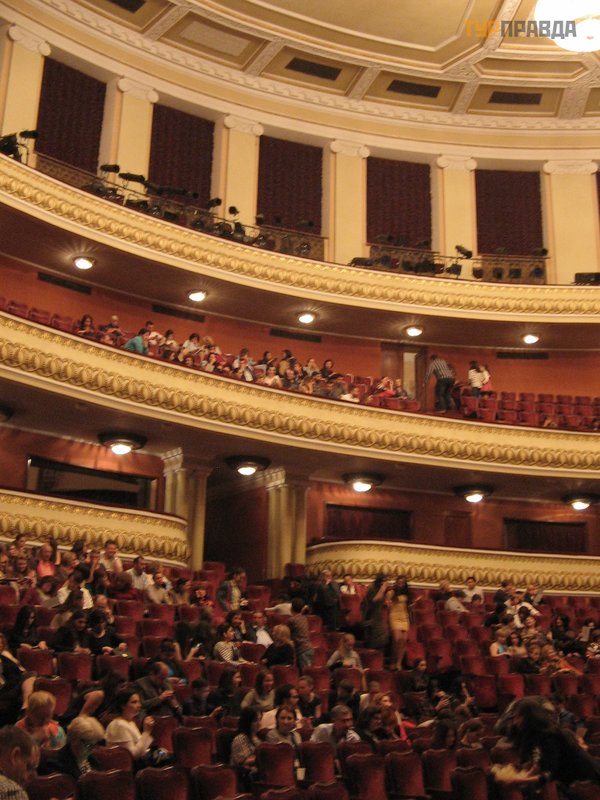 Hall of the Opera Theatre. Spendiarova
Hall of the Opera Theatre. Spendiarova
There are other monuments, both classical and modern, on the boulevard ring.
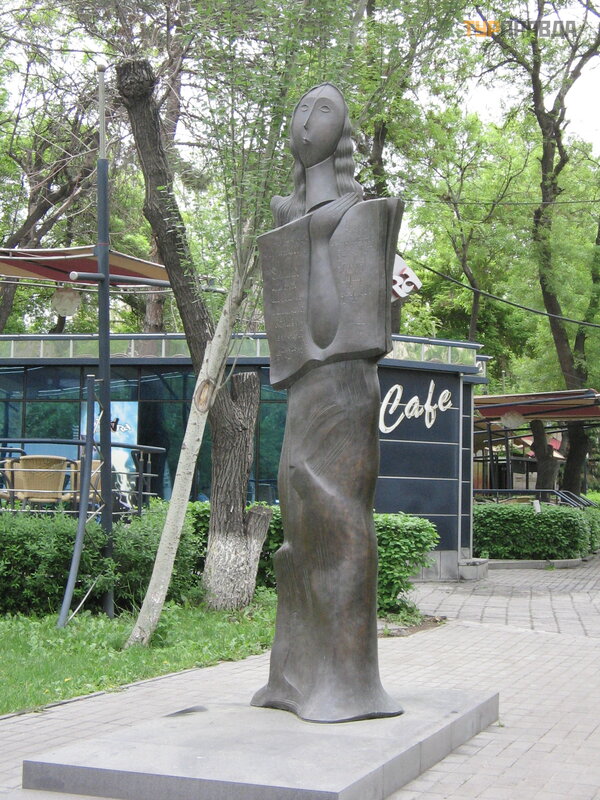 monument to the history of the rescue of the Mush hemidiarium
monument to the history of the rescue of the Mush hemidiarium
And finally, I will mention the promised monuments of the intangible heritage of Armenia, included in the UNESCO list. There are four of them from Armenia.
First, it's lavash. Bread is always "first" among all peoples. Be sure to try it (although they give it everywhere they eat). We were also taken to see how they make lavash. Those who wish could try to roll it out themselves. Only a skillful local resident can stick a cake in the oven (and even then not always successfully).
I'll tell you a legend about lavash.
Once the Kingdom of Van (Urartu) was at war with the king of Assyria. The Armenian king Aram was captured. The Assyrian king suggested to the prisoner: “You will not eat for 10 days, and on the 11th we will compete in archery. If you win, then you are stronger than me, and I will give you freedom. Aram thought all night and in the morning ordered to bring him the best shield from his army, located nearby. The messengers of the Assyrian king conveyed the request of Aram. The warriors puzzled over the meaning of their king's words for a long time. And then they guessed: they hid the pita bread under a shield and handed it to the envoys. No one guessed, because in Assyria they did not know lavash. Aram, seeing the shield, said: "This shield is not good enough, tomorrow bring me another one. " Every day they brought him a new shield with lavash, and every day he sent it back with the same words. On the 11th day, the kings competed in shooting. The Assyrian was sure that Aram was weak from hunger and would lose. But he came out victorious, and therefore was released. Lavash turned out to be his savior. Since then, this bread has been greatly revered in the country.
Secondly, this is duduk. Unfortunately, I can not convey in words the poignant and piercing sound of this instrument. Those who watched Gladiator heard the soundtrack with this instrument. Others can search for music on the net. But I'll tell you the legend about the duduk.
A young wind met an apricot tree. The tree captivated him with its beauty, the wind fell in love with it. He played with flowers, then with leaves and had fun. He hugged his beloved tree with his wings. The hurricane ruler found out about this and became angry. He began to destroy all life on earth. The young wind covered the apricot tree with its wings, trying to protect it. He said that he was ready for any sacrifice to save his beloved tree. The hurricane replied, “Stay with your tree. Your wings will remain. But as soon as you take off, the tree will die. ” The young wind was pleased: he could, as before, hug his beloved tree with his wings. With the onset of autumn, the leaves from the tree flew around, and the young wind had nothing to play with. He got bored. His brothers danced beside him, calling him with them. The young wind could not stand it and rose to them. At the same hour, the apricot tree died. Only a thin branch survived. After some time, a boy who was collecting firewood picked up a twig. He made a pipe-duduk out of a branch. It was worth touching this pipe, and a quiet and sad melody flowed from it.
Thirdly, this is the epic "David of Sasun". I can only place a photo of the monument to this hero in Yerevan near the station. And those who wish to read the epic will have to read it on their own.
Fourthly, these are khachkars. They deserve a separate story. Better yet, see them at least once.
